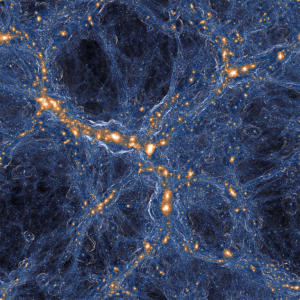Keck Observatory Astronomers Discover Rare ‘Fossil Cloud’

The above image is is a simulation showing galaxies and gas in the universe. The blue filaments represent gas and connect the galaxies (orange) which contain rare pockets of gas clouds left over from the Big Bang. Credit: TNG Collaboration.
A team of astronomers working from W.M. Keck Observatory have discovered a rare cloud of gas that appears to be a relic formed just after the Big Bang.
PhD student Fred Robert and Professor Michael Murphy at Swinburne University of Technology found the cloud, which is one of only three of its kind known in the universe. Their finding provides new insight into how the first galaxies formed.
“Everywhere we look, the gas in the universe is polluted by waste heavy elements from exploding stars,” Robert said. “But this particular cloud seems pristine, unpolluted by stars even 1.5 billion years after the Big Bang.”
“If it has any heavy elements at all, it must be less than 1/10,000th of the proportion we see in our Sun. This is extremely low; the most compelling explanation is that it’s a true relic of the Big Bang.”
The study will be published in the journal Monthly Notices of the Royal Astronomical Society. A preprint of the paper, “Exploring the origins of a new, apparently metal-free gas cloud at z = 4.4,” is available online.
Robert and his team observed a quasar—a supermassive black hole at the center of a galaxy that produces massive amounts of radiation—behind the gas cloud. The quasar, which emits a bright glow, provided a light source highlighting shadows of the hydrogen gas cloud.
“We targeted quasars where previous researchers had only seen shadows from hydrogen and not from heavy elements in lower-quality spectra,” Robert said. “This allowed us to discover such a rare fossil quickly with the precious time on Keck Observatory’s twin telescopes.”
The only other two known fossil clouds were discovered in 2011 by Professor Michele Fumagalli of Durham University; John O’Meara, a former professor at St. Michael’s College and now the chief scientist at Keck Observatory; and Professor J. Xavier Prochaska of the University of California, Santa Cruz. Fumagalli and O’Meara are co-authors on the latest study finding a third fossil cloud.
“The first two were serendipitous discoveries, and we thought they were the tip of the iceberg,” O’Meara said. “But no one has discovered anything similar—they are clearly very rare and difficult to see. It’s fantastic to finally discover one systematically.”
“It’s now possible to survey for these fossil relics of the Big Bang,” Murphy said. “That will tell us exactly how rare they are and help us understand how some gas formed stars and galaxies in the early universe, and why some didn’t.”













